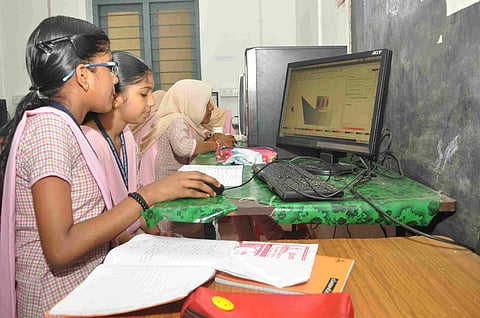

If you ask most Malayali parents what is the best possible education that their children could receive is, their answer will be simple: To send their wards to an exorbitantly priced private school where the medium of instruction is English and that the mark of excellence would be the fluency with which their children speak English.
"The public continues to view the quality of government schools with a sense of skepticism. For this very reason, they are unwilling to send their wards to government schools. With KITE, the government aims to win public confidence and hopes to bring more children to government schools," says K Anvar Sadath, Vice Chairman and Executive Director of KITE.
KITE is an offshoot of the state's Education Department which was set up to promote Information and Communications Technology (ICT) training in government schools across the state. "The initiative was started in 2001 and it is formally known as IT@School. We have numerous flagship programmes like Hi-Tech School, Samagra eResource Portal and Little Kites Club, among many others to promote IT education among high-school students. Some of the subjects students are taught include Animation, Cyber Safety, Hardware, Electronics, and Malayalam computing," Sadath explains.
Over the years, scores of government schools across the state were forced to shut down due to a lack of students. By 2016, 5,715 state schools were running without an adequate number of students. In order to save the existing schools and to increase the quality of education, the government has upped the infrastructure facilities in classrooms across the 3678 schools.
"We ran the Hi-Tech School Project as a campaign and roped in students, teachers, and parents. As a part of this, 45,000 classrooms were turned into hi-tech ones in the span of six months. We equipped the classrooms from 8-12 standards with digital projectors, screens, laptops, and internet connectivity," says Sadath.
Needless to say, the initiative proved to be an immense success. This year alone, around 1.8 lakh students enrolled themselves at various government schools. "While it was 1.4 lakh students last year, 40,000 more students joined this year, indicating their changing interests. With visible changes being made and through our extensive campaigns, the public started to trust us more," Sadath adds.
The success of the programme is largely due to both the government and the public's involvement. Anwar explains, "The government alone wouldn't have been able to achieve this. In the case of the Samagra eResource Portal, for instance, a lot of IT employees have volunteered to help us develop comprehensive learning content." The Portal is a repository of digital resources of all subjects from Class 1 to 12. "It is different from the conventional educational portal. You have the resources in class and you have an internet connection. The lesson plan is a comprehensive one which reaches into the subject, chapter and the learning objectives," Anvar explains.
For a more nuanced learning experience, KITE has partnered with Khan Academy and this project will be piloted in 20 schools. "With this partnership, our long-term vision is to make learning a personalised experience. We will be leveraging technologies like Artificial Intelligence and Analytics for thorough monitoring of a child's aptitude. We will consider all the technological possibilities to enhance and support our curriculum in order to achieve 100 per cent success. But we are careful to not override the curriculum with technology," Sadath concludes.
